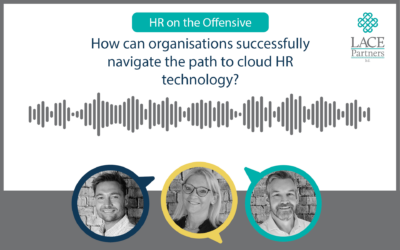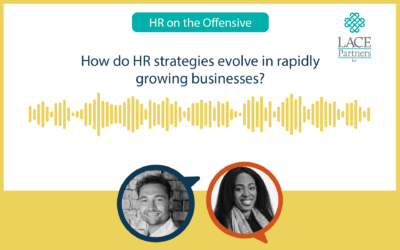This week’s blog ends our Buyer’s remorse with HR technology series and shares takeaways from our recent panel discussion.
We were joined by Sian Beacham, Client Executive Director at LACE Partners, Joanna Murphy, President HCM EMEA at Rizing, and Rob Mooney, Head of SAP SuccessFactors for UK and Ireland. Chris and the panellists delved into the causes of buyer’s remorse and explored strategies for mitigating it.
Is HR technology the root cause of buyer’s remorse?
Buyer’s remorse in HR technology rarely stems from the technology or technology choice itself but from mismatched expectations due to not investigating options and planning the work and the people required to bring such an investment to life.
The root causes of buyer’s remorse
Buyer’s remorse in HR technology can often be traced back to the following key oversights:
- Misaligned objectives: When HR technology does not align with broader business objectives, it may fail to deliver on key strategic people initiatives, leading to disappointment and underutilisation. The business objectives need to be reflected in the Value Case as key outcomes and the benefits quantified and tracked.
- Siloed decision-making: When HR tech decisions are made in isolation without considering the interconnected roles of finance, IT, compliance, and legal departments, the result can be a system that only partially serves the organisation. Alignment from the outset is key.
- Insufficient planning: Rushing into an HR tech purchase without adequate planning and governance can lead to missteps. A lack of clear experience ambition, design principles and a design governance at the outset can muddle the project’s direction and ability to make decisions.
- Pure technology focus: Looking only at HR technology rather than reviewing the operating model and related processes in conjunction with technology enablers. Unless you consider all the moving parts the technology alone cannot be expected to be the saviour!
- Inadequate vendor selection: Failing to conduct a thorough vendor and Implementation Partner (IP) selection exercise can result in a poor fit between your organisation’s needs, culture and the technology solution provided.
- Neglected change management: Underestimating the need for robust change management, including engagement, communication, and training, can severely impact the adoption and utility of new HR technology.
- Lack of value case and benefits realisation tracking: Without clarity on the outcomes and value needed AND the defined responsibility for phased benefits realisation, the case for new HR technology may never be fully actualised or at best, are delayed.
- Lack of data complexity recognition: Insufficient understanding of the resources required, and the key data related activities needed up front. For example, data stewardship, governance and accountabilities, integration principles and approach and prioritising MVP for launch as too many expect to fix everything for Day 1.
- Customisation and localisation: Thinking that all processes need to be fit to the organisation rather than accepting many of the systems have best practice process options – ADOPT, don’t ADAPT!
The user adoption conundrum
A lack of system usage often boils down to one critical area: people. Here is how to pivot the focus:
- Invest in change management: Budget for change management should be substantial; it is the lifeline of user adoption. Planning in advance is vital to successful change and adoption and a successful implementation has the potential for individuals involved in the process becoming heroes.
- Craft a compelling narrative: People need to understand why the change is occurring. This requires a narrative that resonates across the organisation. Thinking about this in terms of persona or workforce segmentation will help individuals understand the benefits of the system in their world and improve its successful adoption, and ongoing acceptance from those around them.
- Lead by example: Leadership must visibly embrace the new HR technology, processes and related operating model and the behaviours it requires.
- Open channels of communication: Listening to feedback and acting upon it is crucial for continual improvement and user satisfaction. It is crucial to have two-way communication.
- Continued focus: Many companies focus on change management and other key activities during the life of a project but neglect the need for post implementation activities. Like caring for a houseplant, tending, and watering needs to happen for the plant to survive and grow. The same lesson applies to post implementation and the overall support model should be considered up front as part of the broader operating model change.
Maximising return on investment
To maximise ROI in HR tech:
- Plan extensively: A well-thought-out plan across all moving parts of people, process and technology is the bedrock of any successful HR technology investment.
- Build a robust value case: Understand the rationale behind the investment, align it with business objectives, and ensure it is quantifiable and clear on accountability.
- Think beyond HR: An inclusive approach that reaches out to IT, finance, payroll, and business units will widen ownership and support.
- React in real-time: Be agile and ready to address conflicts and issues promptly to maintain momentum. Positive implementation is a continuous process of observation and adjustment.
The future of HR technology
To safeguard your investment for the future:
-
- Continuous improvement cycle: Embrace a cycle of deployment, measurement, and revisiting the Value Case to keep the technology, process, and operating model relevant and effective.
- Understand organisational culture: Adoption metrics, sentiment and cultural insights should inform the ongoing use and development of the HR technology.
- Monitor and manage stakeholder expectations: Keeping key stakeholders involved, up to date and understanding the future of HR technology is fundamental to success.
- AI and skills: Recognition that Artificial Intelligence (AI) is now at the forefront of technological improvement, integrating into various applications as assistants and co-pilots to streamline our workflows. Its capability to pinpoint skill gaps and skills matching is a game changer meaning its role in workforce planning and talent marketplaces will be key. As the intricacies of our work increase, AI serves as a navigator, aiding us in developing insights and prompting action.
- AI and human enablement: As concerns increase about AI’s potential to replace human jobs, we need to recognise the importance of the human element of oversight remains integral (E.g. output contextualisation and analysis, emotional intelligence, and sentiment). The AI evolution is giving rise to new job categories, such as conversational analysts and prompt engineers, there will be other jobs developed that we have not yet thought of.
- AI and policy / legislation: There are complexities about the use and intent of AI and we already see the emergence of legislation and policies which will govern AI usage within the workplace. We need to keep a watching brief on this as things develop.
In summary, buyer’s remorse in HR tech investments is DEFINITELY avoidable. By addressing the causes head-on and focusing on people, planning, planning and planning (!), organisations can ensure their HR technology investments are fruitful and future ready. Remember, the right HR technology can be a game-changer for your organisation — it’s about making an informed, aligned, and planned choices and staying adaptable to change and innovation.
Navigating the intricate world of HR technology is undoubtedly complex, but it is also filled with opportunities for transformative growth and efficiency. If you need any help choosing or implementing your HR tech systems, don’t hesitate to contact us by filling the form below.






